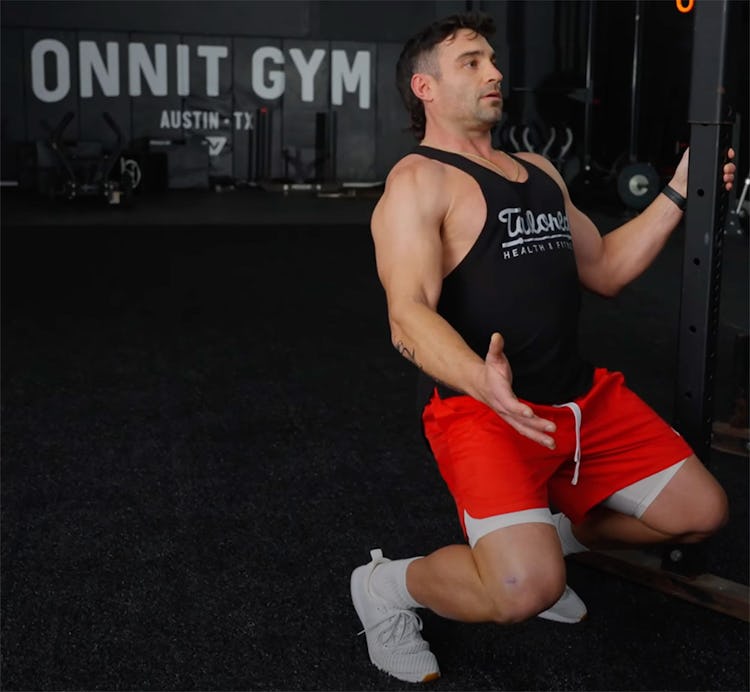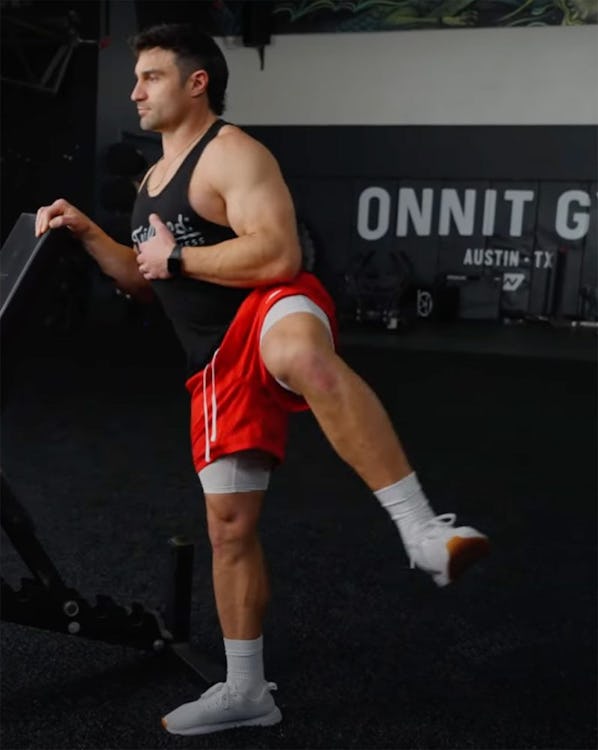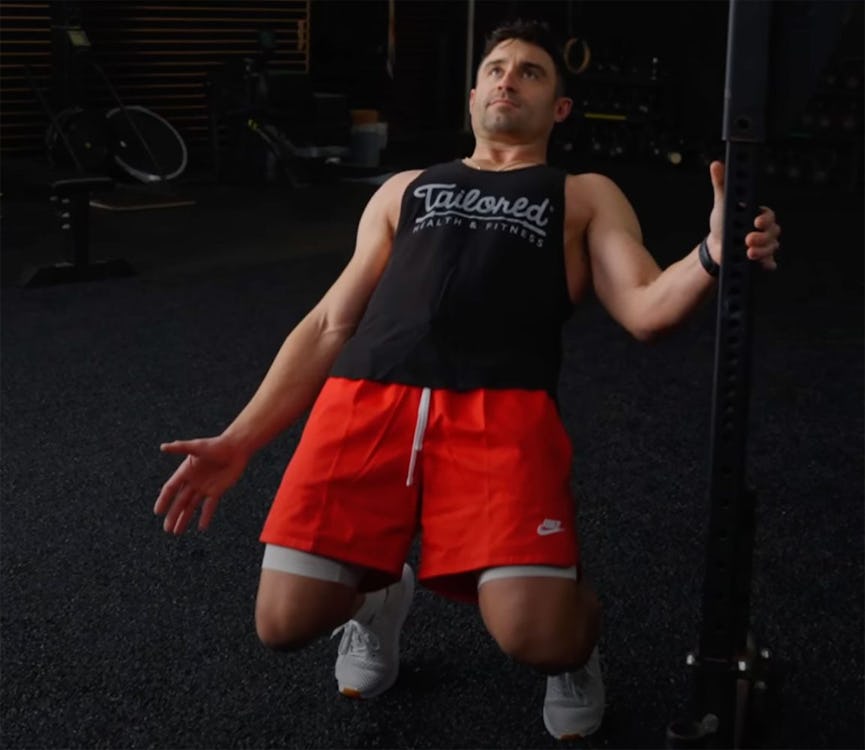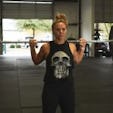The sissy squat is a funny name for an exercise that works your quads through the greatest range of motion possible, and it can help you hit an oft-neglected section of your things. Here’s everything you need to know to perform the sissy squat correctly and get the most out of it.
Key Takeaways
– The sissy squat is the only squat exercise that can train the rectus femoris muscle in a lengthened position.
– The sissy squat requires stability and should be learned by holding onto a sturdy object for support.
– Start with 2–3 sets of 5–10 reps.
– The sissy squat works the vastus medialis (the “tear-drop muscle” on the inner side of the quad), vastus lateralis (outer quad), vastus intermedius (underneath the other quads), and the rectus femoris.
– Do the sissy squat toward the end of a leg workout when your legs (and knees) are warmed up and full of blood.
What Is The Sissy Squat and What Are Its Benefits?
(See 00:24 in the video above.)
The sissy squat is a hell of a leg exercise if you can just get past its funny name. From a standing position, you bend your knees as deeply as you can while keeping your hips locked out. This will cause you to rise up onto the balls of your feet, so, one might argue that the sissy squat makes you look like a ballet dancer, or someone doing a goofy exercise that a meathead might consider a little effeminate—hence the “sissy” name. But the fact is, sissy squats were a favorite of hardcore bodybuilders for decades, and have recently come back into style thanks to social media.
While sissy squats look strange, they really isolate your quads like no other movement, particularly the rectus femoris muscle. Here’s a quick anatomy lesson: Your other quad muscles only work to extend the knee, but your rectus femoris straightens the knee as well as raises your leg in front of you.
Other squatting movements cause you to bend your hips as you bend your knees, so the rectus femoris never really gets trained in a lengthened position. But when you do sissy squats, you keep your hips straight, and that puts a stretch on the rectus femoris, delivering a stimulus it can’t get from front squats, back squats, leg presses, and so on.
This is especially good news because research is mounting that shows muscles may get a better growth stimulus when they’re trained in lengthened positions. In other words, when they’re stretched a bit. Two trials (1, 2) specifically indicated that exercises that trained muscles at longer muscle lengths led to greater muscle gains versus exercises that worked the areas at shorter muscle lengths, though the reasons why are still in dispute.
How To Do The Sissy Squat Correctly

(See 02:00 in the video.)
The sissy squat can be performed without any support, but most people are going to need to hold onto something in order to keep their balance, and that’s how we recommend you learn it.
Step 1. Hold onto the support beam of a power rack or any other sturdy object and stand with your feet between hip and shoulder-width apart. Turn your toes out between 10 and 30 degrees.
Step 2. Brace your abs as if you were about to take a punch to the stomach, and squeeze your glutes. Now begin to slowly bend your knees while leaning your torso back. Allow your heels to come off the floor so you’re balancing on the balls of your feet. Keeping your hips locked out, go as low as you can without discomfort or losing control of the movement. Ideally, you’ll get down to where your knees are fully flexed, with your hamstrings touching your calves.
Step 3. Extend your knees to come back up to standing. Be sure to keep your hips straight as you do so.
What Muscles Does The Sissy Squat Work?
(See 03:00 in the video.)
“The sissy squat works the quads with only minimal assistance from the glutes,” says Jonny Catanzano, an IFBB pro bodybuilder and trainer (@jonnyelgato_ifbbpro), “so it’s a great movement for isolating the quads and strengthening them in an extreme range of motion that really couldn’t be trained any other way.” Specifically, the sissy squat works the vastus medialis (the “tear-drop muscle” on the inner side of the quad), vastus lateralis (outer quad), vastus intermedius (underneath the other quads), and, of course, the rectus femoris, which you’ll remember we said bends the hip as well as extends the knee (it starts below your hip flexors and runs down the middle of your quads).
How Do Sissy Squats Vary From Other Squats?
As we said above, the sissy squat is the only exercise that can work the rectus femoris muscle in a lengthened position, which may prove extra beneficial for muscle growth. Other types of squats require you to bend at the hips as well as the knee, but the sissy squat has you keep your hips straight. The result is a movement that stretches out the rectus femoris while putting all the quad muscles under tension.
How To Stretch Before Doing Sissy Squats
(See 03:51 in the video.)
“Sissy squats take your quads through a full range of motion and into a very big stretch,” says Catanzano, “so make sure you’re very warmed up before you do them.” Here are three exercises he recommends to warm up and stretch out before you do a leg workout that features sissy squats.
1. Hip CARS

(See 04:00 in the video.)
Step 1. Hold onto an inclined bench or other sturdy surface and raise one knee up in front of you. Now move your knee away from your body, trying to get to 90 degrees or as far as you can, but don’t allow your hips to turn in that direction—keep them facing forward.
Step 2. Turn your thigh bone in its socket, so you raise your foot up while you point your knee downward as far as you can. Then kick your leg straight back behind you, feeling your glute engage. Touch your foot back to the floor.
Step 3. Reverse the movement, raising your leg behind you, and then bringing the knee around to the front again. That’s one rep. Do 2–3 sets of 5 reps on each leg to start, working up to 3 sets of 8 reps.
To increase the challenge, place an object on the floor so you have something to raise your leg over and hover above.
2. Knee Lift With Leg Extension
(See 05:20 in the video.)
Step 1. Set up as you did for the hip CARS and raise your knee in front of you. From there, extend your knee fully as if you were kicking.
Step 2. Keep the knee extended as you lower your leg back down. “Try not to bend over as you’re raising the leg, or use momentum to complete the reps,” says Catanzano. Do 3 sets of 5 reps on each leg.
Sissy Squat Alternatives
(See 06:07 in the video.)
The sissy squat is a challenging exercise and can be very awkward when you’re first trying it out. Some people may also find that it bothers their knees. Therefore, you may want to try a couple of other exercises that are a little more user-friendly, but target the quads in a similar way.
Reverse Nordic Leg Extension
(See 06:11 in the video.)
This movement reduces the sissy squat’s range of motion, and allows you to use the floor for extra stability.
Step 1. Place a medicine ball or other object on the floor—you’ll use it to gauge your range of motion. Attach an exercise band to a rack or other sturdy object in front of you (a pullup bar that’s screwed into place works fine too).
Step 2. Get on your knees (you may need to lay a towel down on the floor for comfort) and roll the ball into place about a foot behind you. Grasp the band with both hands. Extend your hips and brace your core—hold this position throughout the exercise.
Step 3. Allow your body to fall back slowly, driving your legs into the floor to resist it, until your back touches the ball. (The band will help control your descent so you don’t crash backward.) You should feel a deep stretch in your quads. Use the band to help you extend your knees to come back up.
“As you get stronger and more mobile on these,” says Catanzano, “slide the ball back a bit further,” until you don’t need the ball and you can touch your hamstrings to your calves. You can also progress the exercise by changing to a lighter band that will provide less assistance.
Catanzano recommends 2 sets of 8–10 reps.
Banded Sissy Squat
(See 08:35 in the video.)
“This move teaches you how to effectively lock out your hips,” says Catanzano. “When you try to learn that on a regular sissy squat, it can be difficult. This is a great way to ease your way into doing a standing sissy squat, especially if you have problems with mobility.”
Step 1. Attach two exercise bands to a sturdy object, like a power rack’s support beam. They should be pretty thick bands, an inch or an inch and a half wide, as they’ll need to be able to support your bodyweight. (We like the selection offered at elitefts.com.) Wrap one band around the bottom of the rack and place a foot through each loop. Slide the band up so it hugs the top of each calf, just below the knee. Now wrap the other band around the rack at roughly shoulder level and grasp an end in each hand.
Step 2. Lean back, using the band in your hands for assistance and the one at your knees for support. Squat as low as you can while keeping your hips extended.
Do 2 sets of 8 reps. As you improve, you can progress to 3–4 sets of 8–12 reps.
How To Fit Sissy Squats Into Your Workout
(See 11:10 in the video.)
Do the sissy squat later in your leg day when you’re very warmed up and have a lot of blood in the quads. Start with 2–3 sets of lower reps—5 or whatever you can manage—and gradually increase reps as you get stronger. When you find you’re able to do more than 10 reps, you can experiment with holding a dumbbell on your chest for extra resistance, or wearing a weighted vest. You can also try the sissy squat unassisted—that is, do it without holding onto something—which will challenge your ability to keep your balance as well as strengthen your quads.

)





